PSEB Solutions for Class 9 Science Chapter 3 Atoms and Molecules
PSEB Solutions for Class 9 Science Chapter 3 Atoms and Molecules
PSEB 9th Class Science Solutions Chapter 3 Atoms and Molecules
→ The idea of divisibility of matter was considered long back in India around 500 R.C.
→ Another Indian Philosopher, Pabuda Katyayama said these particles normally exist in a combined form which gives us various forms of matter.
→ Greek Philosophers-Democritus and Leucippus suggested that if we go on the dividing matter, a stage will come when particles obtained cannot be divided further.
→ Democritus called these indivisible particles atoms.
→ By the end of the 18th century, scientists recognized the difference between elements and compounds and how and why elements combine, and what happens when they combine.
→ Antoine L.Lavoisier gave two important laws of chemical combination given below.
→ According to the law of conservation of mass, mass can neither be created nor destroyed in a chemical reaction.
→ John Dalton provided the basic theory about the nature of matter.
→ Dalton picked up the idea of divisibility of matter and it was based upon laws of chemical combination.
→ Dalton gave Dalton’s atomic theory.
→ According to Dalton’s atomic theory, all matter, whether an element, a compound, or a mixture is composed of small particles called atoms, which are indivisible.
→ Dalton’s theory provided an explanation for the law of conservation of mass and the law of definite proportions.
→ All matter is made up of very tiny particles called atoms which cannot be seen with the naked eye.
→ The elements are represented with the help of symbols.
→ The symbol represents one atom of the element.
→ Berzelius suggested that the symbols of elements be made up from one or two letters of the name of the element.
→ The atomic mass of an element is the average relative mass of one atom of the element as compared to the mass of one atom of carbon-12, taken as 12 a.m.u. (atomic mass unit).
→ According to the latest IUPAC recommendations, a.m.u. has now been replaced by U (uniformed mass).
→ A molecule is in general a group of two or more atoms that are chemically bonded together.
→ A molecule can be defined as the smallest particle of an element or a compound that can exist independently and shows all the properties of that substance.
→ The molecules of an element are constituted by the same type of atoms.
→ The number of atoms constituting a molecule is known as its atomicity.
→ Atoms of different elements join together in definite proportions to form molecules of compounds.
→ Compounds composed of metals and non-metals contain charged species called ions. An ion is a charged particle and can be negatively or positively charged.
→ A negatively charged ion is called an anion and the positively charged ion is called a cation.
→ A group of atoms carrying a charge is known as a polyatomic ion.
→ The chemical formula of a compound is a symbolic representation of its composition.
→ The chemical formulae of different compounds are based upon their valencies.
→ The combining capacity of an element is known as its valency.
→ The molecular mass of a substance is the sum of the atomic masses of all the atoms in a molecule of the substance.
→ The formula unit mass of a substance is a sum of the atomic masses of all the atoms in a formula unit of a substance.
→ One mole of any species (atoms, molecules, ions, or particles) is that quantity in number having mass equal to its atomic or molecular mass in grams.
→ One mole of any substance represents 6.022 × 1023 particles (atoms, molecules, or ions) of it.
→ This number is an experimentally obtained value and is called Avogadro’s number or constant.
→ The mass of 1 mole of a substance is equal to its relative atomic or molecular mass in grams.
- 1 mole = 6.022 × 1023 particle = Relative mass in grams.
→ An Indian philosopher Maharishi Kanad, postulated that if we go on dividing matter (padarth), we shall get smaller and smaller particles.
→ Ultimately, a stage will reach when further division will not be possible. He named these particles ‘Parmanu’.
→ The radius of an atom is expressed in nanometres (nm)
- 1 nm = 10-9 m.
- 109 nm = 1 m.
→ Atom: It is the smallest or ultimate particle of an element that takes part in chemical reactions. It may or may not exist independently.
→ Molecule: It is the smallest or ultimate particle of a substance (element or compound) that can exist freely. It shows all the properties of a substance.
→ Law of conservation of mass: It states that matter (or mass) can neither be created nor destroyed during any known physical or chemical change.
→ Law of definite proportions (or Law of constant compositions): It states that a pure chemical compound is always found to be made up of the same elements combined together in the same fixed ratio by mass.
→ Symbol: It is the shorthand representation of an element. It is made up of one or two letters from the name of the element.
→ Relative atomic mass (RAM) or Atomic mass: It is the average relative mass of one atom of the element as compared to one atom of carbon-12 taken at 12 a.m.u.
→ Relative molecular mass (RMM) or Molecular mass: It is the average relative mass of one molecule of a substance as compared to one atom of carbon-12 taken at 12 a.m.u.
→ Ion: It is an atom or group of atoms carrying some charge and can exist freely in solution.
→ Polyatomic ion: It is an ion having more than one atom.
→ The chemical formula of a molecular compound is determined by the valency of each element.
→ The chemical formula of an ionic compound is determined by the charge on each ion.
→ Mole: It is the amount of substance that contains the same number of particles (atoms/ions/molecules/formula units.) etc. as there are atoms in 12 g of carbon-12.
→ Avogadro’s number or constant is the number of atoms in 12 g of carbon-12. It is denoted by N0 and its value is 6.022 × 1023, N0 = 6.022 × 1023.
→ The molar mass of a substance is the mass of one mole of a substance.
→ Variable valency: When an element shows more than one valency, it is said to have variable valency.
→ Simple radical: A radical which is made up of only one kind of atom is called a simple radical, e.g. Na+, Cl– etc.
→ Atomic mass unit (AMU or u): It is 1/12th of the mass of one atom of carbon (C12- isotope).
→ S.T.P. stands for standard temperature (0°C or 273K) and pressure (1 atmosphere).
→ Molar volume: It is the volume occupied by one mole of a gas and its value at S.T.P./ N.T.P. is 22.4 litres.
→ Valency: It is the combining capacity of an atom of an element and is numerically equal to the number of hydrogen atoms or number of chlorine atoms or double the number of oxygen atoms with which one atom of the element can combine.
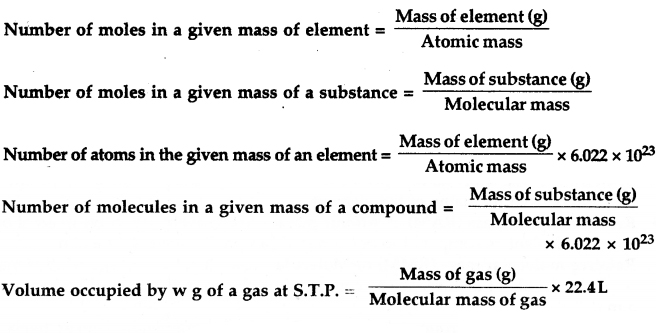

Atomic masses of some common elements in a.m.u. or u.
| Element | Symbol | Atomic Mass | Element | Symbol | Atomic Mass |
| Aluminium | A1 | 27 | Lead | Pb | 208 |
| Argon | Ar | 40 | Lithium | Li | 7 |
| Beryllium | Be | 9 | Magnesium | Mg | 24 |
| Boron | B | 10.8 | Neon | Ne | 20 |
| Bromine | Br | 80 | Mercury | Hg | 201 |
| Calcium | Ca | 40 | Nitrogen | N | 14 |
| Carbon | C | 12 | Oxygen | O | 16 |
| Chlorine | Cl | 35.5 | Phosphorus | P | 31 |
| Copper | Cu | 63.5 | Potassium | K | 39 |
| Fluorine | F | 19 | Silicon | Si | 28 |
| Helium | He | 4 | Silver | Ag | 108 |
| Hydrogen | H | 1 | Sodium | Na | 23 |
| Iodine | I | 127 | Sulphur | S | 32 |
| Iron | Fe | 56 | Zinc | Zn | 65 |
Formulae of a few common compounds
| Name of the compound | Formula | Elements Present |
| Hydrogen | H2 | Hydrogen |
| Nitrogen | N2 | Nitrogen |
| Ammonia | NH3 | Nitrogen, Hydrogen |
| Carbon dioxide | CO2 | Carbon, Oxygen |
| Water | H2O | Hydrogen, Oxygen |
| Sulphur dioxide | SO2 | Sulphur, Oxygen |
| Nitric acid | HNO3 | Hydrogen, Nitrogen, Oxygen |
| Hydrochloric acid | HCl | Hydrogen, Chlorine |
| Sulphuric acid | H2SO4 | Hydrogen, Sulphur, Oxygen |
| Calcium carbonate | CaC03 | Calcium, Carbon, Oxygen |
| Silver nitrate | AgN03 | Silver, Nitrogen, Oxygen |
| Caustic soda | NaOH | Sodium, Oxygen, Hydrogen |
| Caustic potash | KOH | Potassium, Oxygen, Hydrogen |
| Baking soda | NaHC03 | Sodium, Hydrogen, Carbon, Oxygen |
| Phosphoric acid | H3PO4 | Hydrogen, Phosphorus, Oxygen |
| Carbonic add | H2CO3 | Hydrogen, Carbon, Oxygen |
| Nitrous acid | HNO2 | Hydrogen, Nitrogen, Oxygen |
| Marble | CaC03 | Calcium, Carbon, Oxygen |
| Phosphine | PH3 | Phosphorus, Hydrogen |
| Hydrogen sulphide | H2S | Hydrogen, Sulphur |
| Urea | NH2CONH2 | Nitrogen, Hydrogen, Carbon, Oxygen |
| Butane | C4H10 | Carbon, Hydrogen |
| Benzene | C6H6 | Carbon, Hydrogen |
| Acetic acid | CH3COOH | Carbon, Hydrogen, Oxygen |
| Methane | CH4 | Carbon, Hydrogen |
| Soda ash | Na2C03 | Sodium, Carbon, and Oxygen |
Symbols or formulae of some common ions or radicals.
(A) Positive ions or Cations or Electropositive radicals:
(a) Cations having 1+ charges:
| Name | Symbol or Formula |
| Hydrogen | H+ |
| Lithium | Li+ |
| Sodium | Na+ |
| Potassium | K+ |
| Ammonium | NH4+ |
| Silver | Ag+ |
| Cuprous | Cu+ |
| Aurous | Au+ |
| Mercurous | Hg+ |
(b) Cations having 2+ charges:
| Name | Symbol or Formula |
| Magnesium | Mg2+ |
| Barium | Ba2+ |
| Calcium | Ca2+ |
| Strontium | Sr2+ |
| Cobalt | Co2+ |
| Nickel | Ni2+ |
| Manganous | Mn2+ |
| Zinc | Zn2+ |
| Cadmium | Cd2+ |
| Ferrous | Fe2+ |
| Cupric | Cu2+ |
| Mercuric | Hg2+ |
| Plumbous | Pb2+ |
| Stannous | Sn2+ |
| Platinous | Pt2+ |
(c) Cations having 3+ charges:
| Name | Symbol or Formula |
| Ferric | Fe3+ |
| Chromium | Cr3+ |
| Aluminium | Al3+ |
| Auric | Au3+ |
(d) Cations having 4+ charges:
| Name | Symbol or Formula |
| Plumbic | Pb4+ |
| Stannic | Sn4+ |
| Platinic | Pt4+ |
| Manganic | Mn4+ |
(B) Negative ions or Anions or Electronegative radicals:
(a) Anions having 1- charges
| Name | Symbol or Formula |
| Flydride | H– |
| Fluoride | F– |
| Chloride | Cl– |
| Bromide | Br– |
| Iodide | I– |
| Cyanide | CN– |
| Hypochlorite | CIO– |
| Chlorate | ClO3– |
| Perchlorate | ClO3– |
| Bicarbonate | HCO3– |
| Name | Symbol or Formula |
| Bisulphite | HSO3– |
| Bisulphate | HSO4– |
| Bisphide | HS– |
| Hydroxide | OH– |
| Meta-aluminate | AlO2– |
| Nitrite | NO2– |
| Nitrate | NO3– |
| Acetate | CH3COO– |
| Permanganate | MnO4– |
| Sulphocyanide | SCN– |
(b) Anions having 2- charges:
| Name | Symbol or Formula |
| Carbonate | CO32- |
| Sulphite | SO32- |
| Sulphide | S2- |
| Sulphate | SO42- |
| Zincate | ZnO22- |
| Oxide | O2- |
| Manganate | MnO42- |
| Chromate | CrO42- |
| Dichromate | Cr2O72- |
| Oxalate | Cr2O42- |
| Peroxide | O22- |
| Silicate | SiO32- |
(c) Anions having 3- charges:
| Name | Symbol or Formula |
| Nitride | N3- |
| Phosphide | P3- |
| Phosphite | PO33- |
| Phosphate | PO43- |
| Arsenite | AsO33- |
| Arsenate | AsO43- |
| Ferricyanide | [Fe(CN)6]3- |
| Borate | BO33- |
(d) Anions having 4- charges:
| Name | Symbol or Formula |
| Carbide | C4- |
| Ferrocyanide | [Fe(CN)6]3- |
| Pyrophosphate | P2O74- |
PSEB 9th Class Science Important Questions Chapter 3 Atoms and Molecules
Long Answer Type Questions:
Question 1.
(a) Write the important postulates of the Dalton’s Atomic Theory.
(b) Give four drawbacks of Dalton’s Atomic Theory.
Answer:
(a) Dalton’s atomic theory was given by John Dalton in 1808 to e×plain the nature of an atom and the chemical combination in the atoms. The main points of the theory are:
- All matter is made up of a large number of e×tremely small particles called atoms.
- An atom cannot be further divided.
- Atoms are of different kinds. There are as many kinds of atoms as are of elements.
- Atoms of a particular element are identical in all respects i.e. they have same mass and similar properties.
- Atoms of the different elements are different i.e. they have different masses and properties.
- Two or more atoms of the same or different elements combine to form compound atoms or molecules of compounds.
- The number and the nature of atoms in a molecule always remains the same.
- Atoms of the different elements combine in a simple whole number but fi×ed ratios to form compound atoms (now called molecules).
- Atoms of the same element can combine to form two or more compounds.
- Atom can neither be created nor be destroyed.
(b) Drawbacks of Dalton’s Atomic Theory:
- Atom is no longer indivisible.
- Atoms of the same element may not be always identical.
- Atoms of different elements may have same atomic masses.
- It does not e×plain the cause of chemical combination.
Question 2.
How to write a chemical formula of an ionic compound from its radicals?
Answer:
While writing the formula of an ionic compound, the following steps are used :
- Write down the symbol or formula of positive ion to the left and the symbol or formula of the negative ion to the right.
- Shift the valency of positive ion to the lower right of the negative ion and the valency of negative ion to the lower right of the positive ion.
- Take out the common factor if any.
- The formula compound radical is enclosed in small brackets and subscript is put outside the bracket. The subscript 1 is omitted.
Example

Question 3.
How will you write the name of a binary molecular compound?
Answer:
A covalent compound made up of two elements is called a binary molecular compound, e.g. water (H20).
While writing the name of a binary molecular compound, first write the name of the element whose symbol appears on the left hand side in the molecular formula and write down the name of other element. The name of the other element should end with ‘ide’. The prefi×es di, tri, tetra, penta etc. are used to indicate 2, 3, 4, 5…. atoms of an element.
Some examples are:
- Compound – Name
- CO – Carbon mono×ide
- CO2 – Carbon dio×ide
- ZnO – Zinc O×ide
- SO2 – Sulphur dio×ide
- PCl3 – Phosphorus trichloride
- PCl5 – Phosphorus pentachloride
Question 4.
Give one experiment to prove the truth of law of conservation of mass.
Answer:
1. Prepare 5% solution of barium chloride and sodium sulphate in separate beaker.
2. Take a small amount of solution of barium chloride in a conical flask and a small amount of solution of sodium sulphate in an ignition tube.
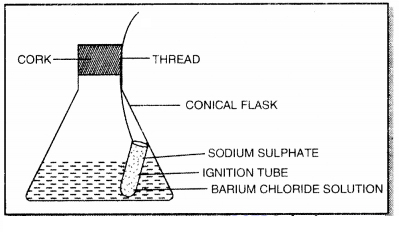
3. Suspend the ignition tube carefully in the conical flask with a thread and cork it.
4. Weigh the flask carefully. To prove the law of conservation of mass
5. Tilt and swirl the flask such that the two solutions get mi×ed and react.
6. Cool the flask to room temperature and again weigh it. The weight remains unchanged showing the truth of the law.
Short Answer Type Questions
Question 1.
Differentiate between an atom and a molecule.
Answer:
| Atom | Molecule |
| 1. It is the smallest particle of an element which takes part in chemical reactions. It may or may not exist freely. | 1. It is the smallest particle of a substance which can exist freely. |
| 2. Generally it is highly reactive. | 2. It is less reactive. |
| 3. It is less stable. | 3. It is more stable. |
| 4. It can’t be sub-divided. | 4. It can be sub-divided. |
Question 2.
(a) What do you understand by the term chemical formula?
(b) What qualitative information is given by the formula NH3?
Answer:
(a) Chemical formula. The symbolic representation of a molecule of a substance is called its chemical formula. It indicates the actual number of atoms of various elements present in one molecule of a substance.
(b) NH3 represents ammonia.
Question 3.
Write down the formulae of:
(a) Aluminium oxide
(b) Aluminium chloride
(c) Hydrogen sulphide
Answer:
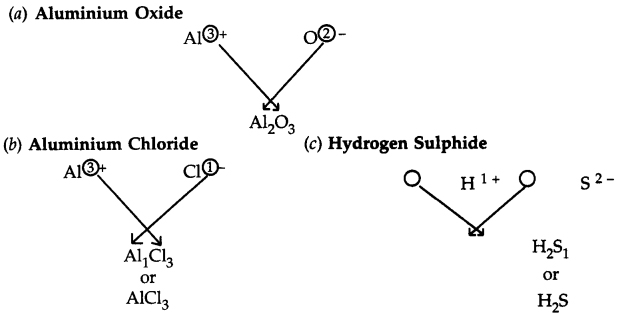
Question 4.
Calculate the relative molecular masses of:
(a) Water (H2O)
(b) Nitric Acid (HNO3).
Answer:
(a) Molecular mass of water (H2O) = 2 × 1 + 16 = 2 +16 = 18u.
(b) Molecular mass of nitric acid (HNO3) = 1 + 14 + 3 × 16 =1 + 14 + 48 = 63u.
Question 5.
Write down the names of the compounds represented by the following formulae:
- Na2CO3
- MgCl2
- Al2 (SO4)2
- K2 S04
- NiS04
- KN03
- CaC03
Answer:
- Sodium Carbonate
- Magnesium Chloride
- Aluminium Sulphate
- Potassium Sulphate
- Nickel Sulphate
- Potassium Nitrate
- Calcium Carbonate.
Question 6.
Work out the formula of:
1. Ammonia
2. Carbon dio×ide
3. Carbon tetrachloride.
Answer:
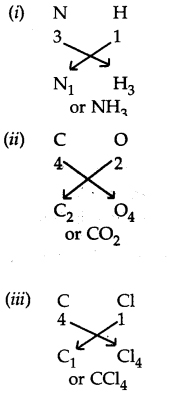
Question 7.
Calculate the number of moles in:
1. 52 g of He
2. 12.044 × 1023 atoms of He
Answer:

Question 8.
Give one e×ample in each case;
(a) Diatomic molecule
(b) Triatomic molecule
(c) Monoatomic molecule
Answer:
(a) Dihydrogen (H2)
(b) Ozone (03)
(c) Helium (He).
Question 9.
An element A has a charge of 3+. Write down the formulae of its:
(a) Chloride
(b) Sulphate
(c) Nitrate and
(d) Phosphate
Answer:
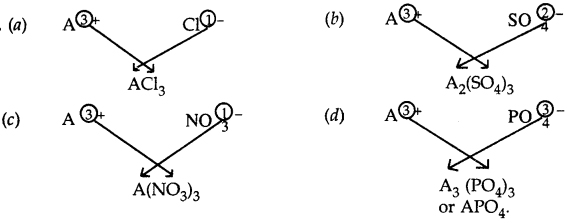
Question 10.
Write the formulae and names of the compounds between:
1. Sodium and sulphate ions
2. Aluminium and chloride ions
Answer:

Question 11.
Write the formulae of the compounds formed by:
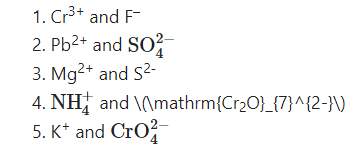
Answer:
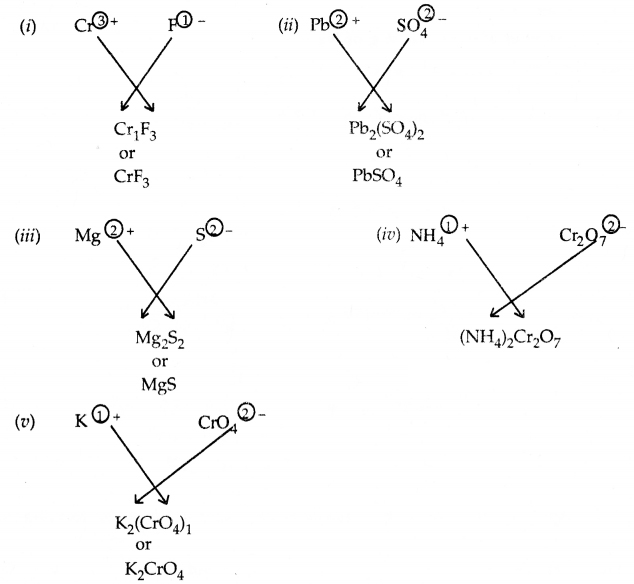
Question 12.
Calculate the formula mass of Na2CO3.10H2O.
Answer:
Formula mass of Na2,CO3.10H2O = 2 × 23 + 12 + 3 × 16 + 10 (2 × 1 + 16)
= 46 + 12 + 48 + 10 (2 + 16)
= 46 + 12 + 48 + 180
= 286 a.m.u.
Question 13.
(a) What do you understand by trivial names of compounds?
(b) Give the chemical names of five such compounds and give their trivial names.
Answer:
(a) The names of the compounds which do not follow any systematic rules are called trivial names or common names.
(b)
| Compound | Chemical name | Trivial name |
| NH3 | Nitrogen trihydride (AZANE) | Ammonia |
| NaCl | Sodium chloride | Common salt or Table salt |
| H2O | Hydrogen hydroxide (OXIDANE) | Water |
| NaOH | Sodium hydroxide | Caustic soda |
| PH3 | Phosphorous trihydride (PHOSPHANE) . | Phosphine. |
Question 14.
Calculate:
1. The number of atoms in 46 g of Na
2. No. of molecules in 8 g of O2
Answer:
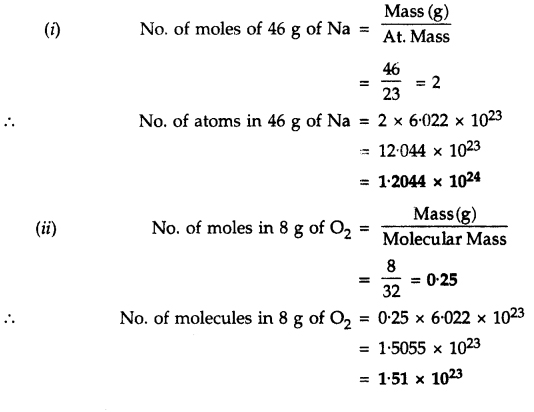
Question 15.
An element × shows two valencies i.e. 2 and 4. Write the formulae of its o×ides.
Answer:

∴ Formula of oxide – xO
Question 16.
Write the formulae of the following salts:
- Zinc carbonate
- Ammonium sulphate
- Barium chloride
- Sodium nitrate
- Lead hydro×ide
- Potassium permanganate
Answer:
- Name of the compound – Formula
- Zinc carbonate – ZnCO3
- Ammonium sulphate – (NH4)2SO4
- Barium chloride – BaCl2
- Sodium nitrate – NaN03
- Lead hydro×ide – Pb(OH)2
- Potassium permangante – KMnO4
Question 17.
Write the names of the following compounds:
- Al2(S04)3
- Mg(HCO3)2
- (NH4)2S
- KMnO4
- KClO3
Answer:
Formula of the Compound Name
- Al2(S04)3 – Aluminium sulphate
- Mg(HC03)2 – Magnesium bicarbonate
- (NH4)2 S – Ammonium sulphide
- KMnO4 – Potassium permanganate
- KClO3 – Potassium chlorate
Numerical Problems (Solved)
Question 1.
Weight of copper o×ide obtained by treating 2.16 g metallic copper with nitric acid and subsequent ignition was 2.70 g. In another e×periment, 1.15 g of copper o×ide on reduction yielded 0.92 g of copper. Show that these results illustrate the law of definite proportions.
Solution:
First experiment
- Weight of copper = 2.16 g
- Weight of copper o×ide = 2.70 g
- Percentage of copper in copper o×ide = 2.16/2.70 × 100 = 80
- Percentage of o×ygen in copper o×ide = 100
Second Experiment
- Weight of copper o×ide = 1.15 g
- Weight of copper = 0.92 g
- Percentage of copper in copper o×ide = 0.92/1.15 × 100 = 80
- Percentage of O in CuO = 100 – 80 = 20
- Since the percentage composition of copper o×ide in the two e×periments is the same. The above results illustrate the law of definite proportions.
Question 2.
Carbon and oxygen combine in the ratio 3 : 8 by mass to form carbon dio×ide. What mass of o×ygen would be required to react completely with 6 g of carbon?
Solution:
3 g of carbon gas reacts with o×ygen = 8 g
∴ 6g of carbon gas will react with o×ygen = 8/3 × 6 = 16 g
Question 3.
In water molecule the ratio by mass in which hydrogen and o×ygen react is 1 : 8. Calculate the ratio by number of atoms in water molecules.
Solution:
| Element | Ratio by mass | Atomic mass | Relative no. of atoms | Simplest Atomic ratio |
| H | 1 | 1 | 1/1 = 1 | 2 |
| O | 8 | 16 | 8/16 = 1/2 = 0.5 | 1 |
∴ Ratio by atoms in water molecule is H : O
2 : 1
Question 4.
Calculate the formula masses of the compounds whose formulae are given below:
- MgO
- CaCl2
- CaC03
Solution:
Formula mass of
- MgO – 24 + 16 – 40 amu
- CaCl2 = 40 + 2 × 35.5 = 40 + 71 = 111 amu
- CaC03 = 40 + 12 + 3 × 16 – 100 amu
Question 5.
What is the weight of 01 mole of HCl?
Solution:
Molecular weight of HCl = 1 + 35.5 = 36.5
Therefore, according to the mole-concept,
Weight of 1 mole of HCl = 36.5 g
∴ Weight of 0.1 mole of HCl = 36.5 × 01 g = 3.65 g
Question 6.
How many g of H2O are present in 0.2 mole of it?
Solution:
Molecular weight of H2O = 2 × 1 + 16 = 18
Therefore according to the mole-concept,
Number of grams present in 1 mole of H2O = 18
∴ Number of grams present in 0-2 mole of H2O = 0.2 × 18 = 3.6.
Question 7.
What is the mass of 0.1 mole of CO2 in g?
Solution:
Molecular weight of CO2 = 12 + 2 × 16 = 44
Therefore according to the mole concept
Mass of 1 mole of CO2 = 44 g
∴ Mass of 0.1 mole of CO2 = 44 × 0.1 g = 4.4 g
Question 8.
Calculate the number of moles of phosphorus atoms (P) in 100 g of phosphorus (Atomic mass of P = 31).
Solution:
The gram atomic mass of phosphorus (P) = 31 g
31 g of phosphorus atoms = 1 mole
100 g of phosphorus atoms = 100/31 =3.2 moles.
Question 9.
How many grams of o×ygen gas contain the same number of molecules as are present in 16 grams of sulphur dioxide? (Atomic masses : S = 32, O = 16).
Solution:
Gram molecular mass of sulphur dio×ide (S02) = 32 + 2 × 16 = 64 g
64 g of S02 contains = 6.022 × 1023molecules
∴ 16 g of S02 contains = \(\frac{6.022 × 1023}{64}\) × 16 = 1.5 × 1023 molecules
Gram molecular mass of o×ygen (O2) = 32 g
Gram Molecular mass of O2 contain = 6.022 × 1023molecules
Now 6.022 × 1023 molecules of O2 = 32 g
∴ 1.5 × 1023 molecules of O2 = \(\frac{32 × 1.5 × 1023}{6.022 × 1023}\) = 7.97 g
Question 10.
What is the mass in grams of each of the following:
(a) 1.0 mole of Ag
(b) 0.5 mole of Mg
(c) 6.023 × 1023 atoms of P?
(Atomic mass : Ag = 108, Mg = 24, P = 31).
Solution:
(a) Atomic mass of Ag = 108
Gram atomic mass of Ag = 108 g
Gram atomic mass of Ag is the mass of 1.0 mole of Ag atoms.
∴ Mass of 1.0 mole of Ag atoms in grams = 108 g
(b) Atomic mass of Mg = 24
Gram atomic mass of Mg = 24 g
Gram atomic mass of Mg is the mass of 1.0 mole of Mg atoms
∴ Mass of 1 mole of Mg atoms in grams = 24 g
Mass of 0.5 mole of Mg atoms in grams = 24 × 0.5 = 12 g
(c) Atomic mass of P = 31
Gram atomic mass of P = 31 g
Gram atomic mass of P contains 6.023 × 1023 atoms of P
6.023 × 1023 atoms of P weigh = 31 g.
Question 11.
Calculate the number of o×ygen atoms in 010 mole of Na2CO3 . 10H2O.
Solution:
Number of oxygen atoms in one molecule of Na2CO3.10H2O
= 3 + 10 = 13
∴ Number of oxygen atoms in 1 mole of Na2CO3.10H2O
= 13 moles
= 12 × 6.022 × 1023
= 78.286 × 1023
= 7.8 × 1024
Question 12.
Calculate the actual weight of:
(a) an atom of oxygen
(b) a molecule of NH3.
Solution:
(a) Atomic weight of oxygen = 16
∴ 1 gram atom of oxygen = 16 g
According to the mole concept,
Number of atoms in 16 g of oxygen = 6.023 × 1023
i.e. Actual weight of 6.022 × 1023 atoms of oxygen = 16 g
∴ Actual weight of 1 atom of oxygen = \(\frac{16}{6.022 × 1023}\) g
= 2.651 × 1023 g
(b) Molecular weight of ammonia (NH3) = 14 + 3 × 1 = 17
∴ 1 mole of ammonia = 17 g
Question 13.
Find the number of molecules in 1.8 g of H2O.
Solution:
Molecular weight of H2O = 2 × 1 + 16 = 18
∴ According to mole-concept,
Number of molecules in 18 g of H2O = 6.022 × 1023
= 6.022 × 1023
∴ Number of molecules in 1.8 g of H2O =
\(\frac{6.022 × 1023}{18}\) × 18
= 6.022 × 1022
Question 14.
Which of the following would weigh most?
(a) 1 Mole of H2O
(b) 1 Mole of CO2
(c) 1 Mole of NH3
(d) 1 Mole of CO
Answer:
1 Mole of H2O = (2 × 1 + 16) g = 18 g
1 Mole of CO2 = (12 + 2 × 16) g = 44 g
1 Mole of NH3 = (14 + 3 × 1) g = 17 g
1 Mole of CO = (12 + 16) g = 28 g
∴ 1 Mole of CO2 weighs most.
Question 15.
Calculate the number of moles of phosphorus atoms in 100 g of phosphorus. If phosphorus is considered to contain P4 molecules, then how many moles it has?
Solution:
Atomic mass of phosphorus = 31
∴ According to mole-concept,
Number of moles of phosphorus in 31 g = 1
Number of moles of phosphorus in 100g = 1/31 × 100 = 3.22
If phosphorus is considered to contain P4 molecules, then according to mole-concept, Number of moles in 4 × 31 i.e. 124 g = 1
∴ Number of moles in 100 g = 1/124 × 100 = 0.805
Question 16.
Find the number of hydrogen atoms in 0.1 mole of H2SO4.
Solution:
Number of hydrogen atoms in 1 mole of H2SO4 = 2 × 6.022 × 1023
Number of hydrogen atoms in 0-1 mole of H2SO4 = 0.1 × 2 × 6.022 × 1023
= 1.2044 × 1023 = 1.2 × 1023
Question 17.
Calculate the number of atoms in each of the following:
(a) 52 moles of He
(b) 52 amu of He
(c) 52 g of He
Solution:
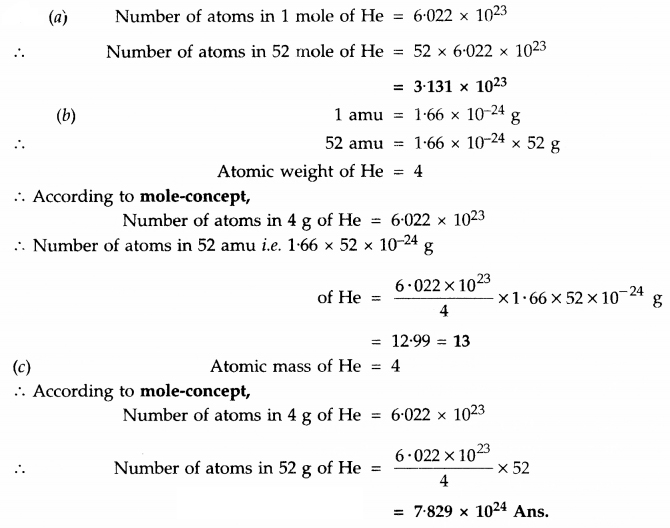
Very Short Answer Type Questions:
Question 1.
When did Indian philosophers thought of division of matter?
Answer:
Around 500 B.C.
Question 2.
What was the view of Maharishi Kanad regarding the division of matter?
Answer:
The smallest particle of matter will be indivisible.
Question 3.
What was the name of smallest indivisible particle by Kanad?
Answer:
Atom.
Question 4.
Which two Greek philosophers considered smallest particle as indivisible?
Answer:
Democritus and Leucippus.
Question 5.
What is the ratio by mass of H and O in water?
Answer:
1 : 8.
Question 6.
What is the ratio by mass of N and H in NH3?
Answer:
14 : 3,
Question 7.
What is Prout’s law of constant composition?
Answer:
A pure chemical compound is always made up of same elements combined together in the same fixed ratio by mass.
Question 8.
Who gave Atomic theory?
Answer:
John Dalton.
Question 9.
When did John Dalton gave atomic theory?
Answer:
In 1808.
Question 10.
What are the units used to e×press the atomic radius?
Answer:
Nanometre (nm).
Question 11.
What is the relationship between m and nm?
Answer:
1 nm = 10-9m.
Question 12.
What is the building block of all matter?
Answer:
Atom.
Question 13.
Who was the first scientist which used symbols for elements?
Answer:
Dalton.
Question 14.
What was special about symbols of elements given by Berzelius?
Answer:
The symbols of elements were represented by one or two letters of the name of the element.
Question 15.
What were the units used for e×pressing atomic masses of elements initially?
Answer:
Initially 1 /16th of mass of an atom of naturally occuring oxygen (016-isotope) was taken as unit.
Question 16.
When was C12 isotope universally accepted as standard reference for expressed atomic masses?
Answer:
In 1961.
Question 17.
Which unit is used now-a-days to e×press atomic masses?
Answer:
It is 1 /12th of mass of an atom of carbon (C12 – isotope).
Question 18.
Name the smallest particle of an element or compound which can exist freely?
Answer:
Molecule.
Question 19.
What is obtained when the atoms of the same element combine?
Answer:
Molecule.
Question 20.
How many atoms are present in oxygen molecule.
Answer:
Two, hence, it is called diatomic molecule (O2).
Question 21.
Give four examples of diatomic molecules.
Answer:
H2, O2, N2 and Cl2.
Question 22.
Give one example of tetra-atomic molecule.
Answer:
Phosphorous, (P4).
Question 23.
Give one example sample of octa-atomic molecule.
Answer:
Sulphur, (S8).
Question 24.
What is produced when three atoms of oxygen combine.
Answer:
Ozone (O3).
Question 25.
Name isotopes of carbon.
Answer:
C12, C13 and C14.
Question 26.
What is the ratio by mass of C and O in carbon dioxide?
Answer:
3 : 8
Question 27.
What is the ratio by number between the atoms of H and O in water?
Answer:
2 : 1
Question 28.
Define an ion.
Answer:
It is an atom or group of atoms having charge (positive or negative).
Question 29.
What is a cation?
Answer:
It is an ion having positive charge.
Question 30.
What is an anion?
Answer:
It is an ion having negative charge.
Question 31.
What is the ratio by mass of Ca nd O in calcium oxide (CaO)?
Answer:
5 : 2
Question 32.
What is the ratio by mass of Mg and S in magnesium sulphate?
Answer:
3 : 4
Question 33.
What is the ratio by mass of Na and Cl in sodium chloride (NaCl)?
Answer:
23 : 35.5
Question 34.
Define chemical formula?
Answer:
It is the symbolic representation of a molecule of a substance.
Question 35.
Define valency.
Answer:
It is the combining capacity of an atom of the element.
Question 36.
What are diatomic molecules?
Answer:
These are made up of two atoms made up of same or different elements.
Question 37.
Define molecular mass of a subtance?
Answer:
It is the average relative mass of one molecule of substance as compared to the mass of one atom of carbon, (C12-isotope).
Question 38.
Which unit is used for expressing molecular masses?
Answer:
a.m.u.
Question 39.
What is the new name given to a.m.u. by IUPAC?
Answer:
U (Unified).
Question 40.
Name the elements present in water (H2O).
Answer:
Hydrogen and oxygen.
Question 41.
What is one mole of an element?
Answer:
It is the number of an element whose mass in grams is numerically equal to its atomic mass e×pressed in a.m.u. or 1 gram atom of an element represents one mole.
Question 42.
What is Avogardro’s number?
Answer:
Avogardro’s number contains 6.022 × 1023 particles.
Question 43.
How is Avogadro’s number denoted?
Answer:
By No or NA.
Question 44.
In what ratio elements combine to form a compound?
Answer:
In a fixed ratio by mass.
Question 45.
Which scientist gave law of conservation of mass?
Answer:
Russian scientist Lavoisier in 1756.
Question 46.
Which scientist gave law of constant composition?
Answer:
French scientist Joseph L. Proust in 1799.
Question 47.
What does a.m.u. represent?
Answer:
It is the unit used to express atomic masses.
Question 48.
Which isotope of carbon is used as a standard reference to express atomic masses?
Answer:
C12 – isotope.
Question 49.
Most of the elements have fractional atomic masses, what does it show?
Answer:
This indicates the existence of isotopes of an element.
Question 50.
What is molar mass?
Answer:
It is the mass of 1 mole of a substance in grams.
Question 51.
Define gram atomic mass.
Answer:
It is the mass of 1 mole of atoms (6.022 × 1023) in grams.
Question 52.
How many atoms are present in 1 gram atom of an element?
Answer:
6.022 × 1023.
Question 53.
Do 1 mole of sodium and calcium have different number of atoms?
Answer:
No, they have same number of atoms.
Question 54.
Lead nitrate solution and sodium chloride solution taken in separate beakers. The beakers were weighed and mixed in one beaker and the beaker was weighed again. Does weight remains unchanged or not? On what principle, the answer is based upon?
Answer:
The weight remains unchanged. It is based upon law of conservation of mass.
Question 55.
28 g of magnesium oxide is produced by the combination of 12 g of magnesium and 16 g of oxygen. Which law is illustrated by this data?
Answer:
Law of conservation of mass.
Question 56.
Do 1 mole of Na and 02 have same mass?
Answer:
No, 1 mole of Na has mass = 23 g
1 mole of O2 has mass = 32 g
Question 57.
1 mole represents particles …………. .
Answer:
6.022 × 1023.
Question 58.
The molar mass of NH3 is
Answer:
17 g.
Question 59.
An element Z has a valency of 3. Write down the formula of its oxide?
Answer:
Z2O3.
Question 60.
How many atoms are present in 0.012 kg of C12 – isotope? What is this number called?
Answer:
6.022 × 1023 atoms. This number is called Avogadro’s number.
Question 61.
Write down the formula of compound made up of Al3+ and [latetx]\mathrm{SO}_{4}^{2-}[/latex].
Answer:
Al2 (SO4)3
Question 62.
How many molecules are present in 9 g of water?
Answer:
9/18 × 6.0222 × 1023 = 3.011 × 1023 molecules.
Question 63.
What is the molecular mass of HN03. (Atomic masses, H = lu, N = 14u, 0 = 16u)
Answer:
1 + 14 + 3 × 16 = 1 + 14 + 48 = 63u.
Question 64.
What are polyatomic ions?
Answer:
It is a group of atoms having net charge, e.g. NH+4, CO32- etc.
Question 65.
The molecular formula of aluminium sulphate is ……….. .
Answer:
Al2(SO4)3
Science Guide for Class 9 PSEB Atoms and Molecules InText Questions and Answers
Question 1.
In a reaction, 5.3 g of sodium carbonate reacted with 6 g of ethanoic acid. The products were 2.2 g of carbon dioxide, 0.9 g water and 8.2 g of sodium ethanoate. Show that these observations are in agreement with the law of conservation of mass.
Sodium carbonate + ethanoic acid → sodium ethanoate + carbon dioxide + water.
Answer:
Sodium carbonate + ethanoic acid → sodium ethanoate + carbon dioxide + water.
- Mass of sodium carbonate = 5.3 g
- Mass of ethanoic acid = 6.0 g
- Total mass of the reactants = 5.3 + 6.0 = 11.3g
- Mass of carbon dioxide = 2.2 g
- Mass of water = 0.9 g
- Mass of sodium ethanoate = 8.2 g
- Total mass of the products = 2.2 + 0.9 + 8.2 = 11.3 g
Since total mass of the reactants = Total mass of the products
Hence, the Law of Conservation of Mass is true.
Question 2.
Hydrogen and oxygen combine in the ratio of 1:8 by mass to form water. What mass of oxygen gas would be required to react completely with 3 g of hydrogen?
Answer:
One g of hydrogen gas reacts with oxygen = 8 g
3 g of hydrogen gas will react with oxygen = 3 × 8 = 24 g
Question 3.
Which postulate of Dalton’s atomic theory is the result of the law of cosnervation of mass?
Answer:
Law of conservation of mass is based upon the postulate that atoms are indivisible particles and can neither be created nor destroyed during any chemical reaction.
Question 4.
Which postulate of Dalton’s atomic theory can explain the law of definite proportions?
Answer:
Atoms of various elements combine in simple whole-number but the fixed ratio to form compound atoms (molecules).
Question 5.
Define the atomic mass unit.
Answer:
One atomic mass unit is a mass unit and it is equal to 1/12th of the mass of an atom of carbon-12.
1 a.m.u. = 1.66 × 10-27 kg
Question 6.
Why is it not possible to see an atom with naked eyes?
Answer:
This is because atoms are very-very small. The radius of an atom is of the order of 10-10 m.
Question 7.
Write down the formulae of
1. Sodium oxide
2. Aluminium chloride
3. Sodium sulphide
4. Magnesium hydroxide.
Answer:

Question 8.
Write down the names of the compounds represented by the following formulae,
- Al2 (S04)3
- CaCl2
- K2S04
- KN03
- CaCO3
Answer:
- Aluminium sulphate
- Calcium chloride
- Potassium sulphate
- Potassium nitrate
- Calcium carbonate.
Question 9.
What is meant by the term chemical formula?
Answer:
Chemical formula. The chemical formula of a substance indicates its constituent elements and number of atoms of each combining element present in One molecule of it.
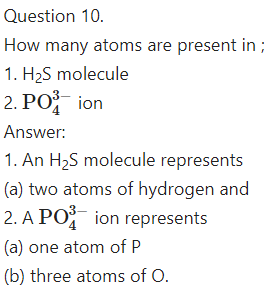
Question 11.
Calculate the molecular masses of H2, O2, Cl2, CO2, CH4, C2H6, C2H4, NH3, CH3OH.
Answer:
- Molecular mass of H2 = 2 × 1 = 2u
- Molecular mass of 02 = 2 × 16 = 32 u
- Molecular mass of Cl2 = 2 × 35.5 = 71.0 u
- Molecular mass of C02 = 1 × 12 + 2 × 16 = 12 + 32 = 44 u
- Molecular mass of CH4 = 12 + 4 × 1 = 12 + 4 = 16 u
- Molecular mass of C2H6 = 2 × 12 + 6 × 1 = 24 + 6 = 30 u
- Molecular mass of C2H4 = 2 × 12 + 4 × 1 = 24 + 4 = 28 u
- Molecular mass of NH3 = 14 + 3 × 1 = 14 + 3 = 17 u
- Molecular mass of CH3OH = 12 + 3 × 1 + 16 + 1 = 12 + 3 + 16 + 1 = 32 u
Question 12.
Calculate the formula unit masses of ZnO, Na2O, K2C03.
(Given atomic masses of Zn = 65 u, Na = 23 u, C = 12u and O = 16 u)
Answer:
- Formula unit mass of ZnO = 65 + 16 = 81 u
- Formula unit mass of Na2O = 2 × 23 + 16 = 46 + 16 = 62 u
- Formula unit mass of K2C03 = 2 × 39 + 12 + 3 × 16 = 78 + 12 + 48 = 138 u
Question 13.
If one mole of carbon atoms weigh 12 gram. What is the mass (in grams) of 1 atom of carbon?
Answer:
1 mole of carbon has mass = 12 g
Mass of 1 atom of carbon = 12/6.023×10
= 1.99 × 10– 23g
Question 14.
Which has more number of atoms, 100 grams of sodium or 100 grams of ion (given atomic mass of Na = 23 u, Fe = 56 u)?
Answer:
Atomic mass of sodium = 23 u
1 mole of sodium has mass = 23 g
No. of moles of sodium in 100 g = 100/23
∴ No. of atoms of sodium in 100 g
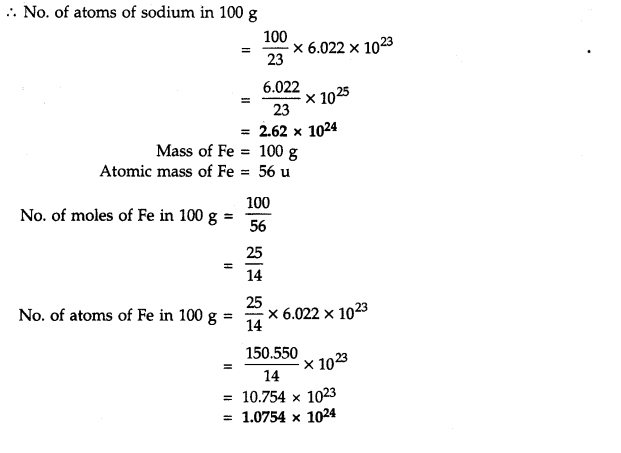
∴ 100 g of sodium has more atoms.
PSEB 9th Class Science Guide Atoms and Molecules Textbook Questions and Answers
Question 1.
A 0.24 g sample of a compound of oxygen and boron was found by analysis to contain 0.096 g of boron and 0.144 g of oxygen. Calculate the percentage composition Of the compound by weight.
Answer:
Weight of compound = 0.24 g
Weight of Boron = 0.096 g
Weight of oxygen = 0.144 g
∴ % age of B = 0.096/0.24 × 100
= 96/240 × 100 = 40
% age of O = 0.144/0.240 × 100 = 60
Question 2.
When 3.0 g of carbon is burnt in 8.00 g oxygen, 11.00 g of carbon dioxide is produced. What mass of carbon dioxide will be formed when 3.00 g of carbon is burnt in 50.00 g of oxygen? Which law of chemical combination will govern your answer?
Answer:
3.00 g of carbon combines with 8.00 g of oxygen to produce 11.00 g of carbon dioxide
C + O2 → CO2
When 3.00 g of carbon is burnt in 50.00 g of oxygen, 11.00 g of carbon dioxide is produced. This is based upon the law of constant compositions.
Question 3.
What are polyatomic ions? Give examples.
Answer:
Polyatomic ions. A group of atoms carrying a charge (+ve or -ve) is called a polyatomic ion.
![]()
Question 4.
Write the chemical formulae of the following :
(a) Magnesium chloride
(b) Calcium oxide
(c) Copper nitrate
(d) Aluminium chloride
(e) Calcium carbonate
Answer:
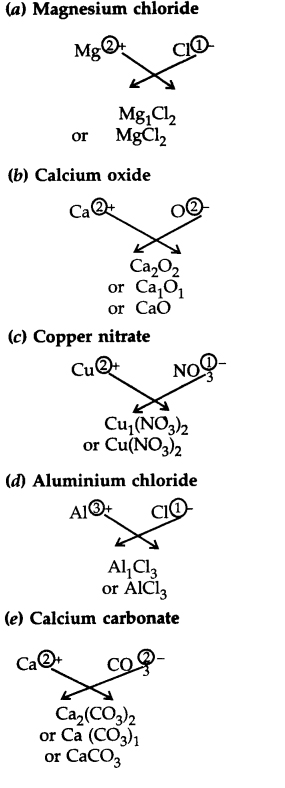
Question 5.
Give the names of the elements present in the following compounds:
(a) Quick lime
(b) Hydrogen bromide
(c) Baking powder
(d) Potassium sulphate
Answer:
(a) Quick lime (CaO). The elements present in it are calcium and oxygen.
(b) Hydrogen bromide (HBr). The elements present in it are hydrogen and bromine.
(c) Baking powder (NaHC03). The elements present in it are sodium, hydrogen, carbon and oxygen.
(d) Potassium sulphate (K2S04). The elements present in it are Potassium, Sulphur and Oxygen.
Question 6.
Calculate the molar mass of the following substances:
(a) Ethyne, C2H2
(b) Sulphur molecule, S8
(c) Phosphorus molecule, P4 (Atomic mass of phosphorus is 31)
(d) Hydrochloric acid, HCl
(e) Nitric acid, HNO3
Answer:
(a) Molar mass of ethyne, C2H2 = 2 × 12 + 2 × 1 = 24 + 2 = 26 g
(b) Molar mass of sulphur molecule, S8 = 8 × 32 = 256 g
(c) Molar mass of Phosphorus molecule, P4 = 4 × 31 = 124 g
(d) Molar mass of hydrochloric acid, HCl = 1 + 35.5 g = 36.5 g
(e) Molar mass of nitric acid, HNO3 = 1 + 14 + 3 × 16 = 1 + 14 + 48 = 63g
Question 7.
What is the mass of:
(a) 1 mole of nitrogen atoms?
(b) 4 moles of aluminium atoms (Atomic mass of aluminium = 27)?
(c) 10 moles of sodium sulphite (Na2S03)?
Answer:
(a) Mass of 1 mole of Nitrogen atoms = 14 g
(b) Mass of 1 mole of A1 atoms = 27 g
Mass of 4 moles of A1 atoms = 4 × 27 = 108 g
(c) Mass of 1 mole of sodium sulphite, Na2SO3
= 2 × 23 + 32 + 3 × 16
= 46 + 32 + 48 = 126 g
∴ Mass of 10 moles of Na2SO3 = 10 × 126 = 1260 g
Question 8.
Convert into moles:
(a) 12 g of oxygen gas
(b) 20 g of water
(c) 22 g of carbon dioxide
Answer:
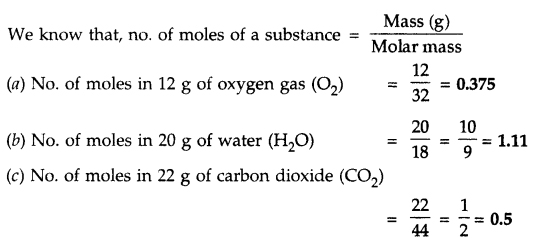
Question 9.
What is the mass of:
(a) 0.2 mole of oxygen atoms?
(b) 0.5 mole of water molecules?
Answer:
(a) 0.2 mole of oxygen atoms:
Mass of 1 mole of oxygen atoms = 16 g
Mass of 0.2 mole of oxygen atoms = 0.2 × 16 = 3.2 g
(b) 0.5 mole of water molecules:
Mass of 1 mole of water molecule (H2O) = 18 g
∴ Mass of 0.5 mole of water molecules = 0.5 × 18 = 9 g
Question 10.
Calculate the number of molecules of sulphur(S8) present in 16 g of solid sulphur.
Answer:
Mass of solid sulphur (S8) = 16 g
Mass of 1 mole of sulphur (S8) = 8 × 32 = 256 g
No. of molecules in 16 g of solid sulphur = 16/256 × 6. 023 × 1023
= 3.76 × 1022 molecules
Question 11.
Calculate the number of aluminium ions present in 0.051 g of aluminium oxide.
(Hint: The mass of an ion is the same as that of an atom of the same element.
The atomic mass of Al = 27 u)
Answer:
Mass of 1 mole of aluminium oxide (Al2O3) = 2 × 27 + 3 × 16 = 54 + 48 = 102 g
1 mole of Al2O3 contains Al3+ ions = 2 × 27 = 54 g
or 102 g of Al2O3 contains Al3+ contains = 54 g
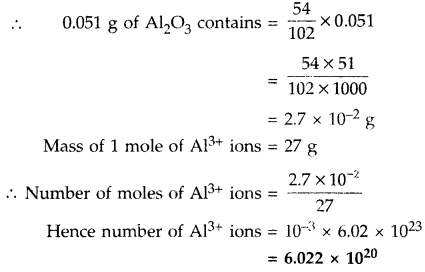
Follow on Facebook page – Click Here
Google News join in – Click Here
Read More Asia News – Click Here
Read More Sports News – Click Here
Read More Crypto News – Click Here